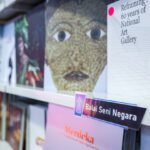Kiesendahl + Calhoun Fine Art, Ltd. adds a special touch to The Lodge.
Abby Carmody
“Taking the time to observe and engage in original art is a thought-provoking act that enhances a sense of wonder and curiosity,” says Nancy Kiesendahl Bloch. “Allowing ourselves to really observe and explore our feelings when we are in front of a work of art can stimulate deep awareness. Are we drawn to the dynamics of form, color and line? Do we appreciate abstraction or tend towards the more realistic representation of the world? What art interests us or evokes a visceral sense of joy?”
These intriguing questions, and the way we respond to them, contribute to the deep, personal feelings emoted by art. No matter the medium, there’s no denying that art stirs the senses unlike most forms of expression.
Kiesendahl, left, and Calhoun have been curators since 2006.
Kiesendahl + Calhoun Fine Art, Ltd.
Nancy Kiesendahl Bloch and Camilla Calhoun, co-curators and owners of Kiesendahl + Calhoun Fine Art, Ltd. at the Lodge at Woodloch, an exquisite destination spa in the Pocono Mountains of Pennsylvania, have been curating seasonal exhibits in the gallery hall since the Lodge’s inception in 2006. The gallery represents over 80 artists, established and emerging, local and international, whose work, both abstract and representational, offers guests the unique opportunity to enjoy fine art throughout their stay at The Lodge.
“The Lodge at Woodloch is unique in these offerings and the Art Gallery that guests pass through several times a day during their stay is uplifting and is a special part of the shared experience at The Lodge,” explains Kiesendahl Bloch.
Calhoun adds, “Our gallery was first located in Beacon, New York and then the Lodge at Woodloch reached out to us to provide an art experience for their guests. Our guests often comment about how much they enjoy having The Gallery as an additional feature of wellness and that it is very uplifting for them. We try to choose work that involves nature and beauty which help with the wellness and good spirit of The Lodge.”
“The Village Garden” by Nancy Campbell.
Kiesendahl + Calhoun Fine Art, Ltd.
Art and wellness are intrinsically connected, impacting mental, emotional and even physical health. Engaging with art, whether creating or appreciating it, can reduce stress, improve mood, enhance cognitive function and foster social connections, ultimately contributing to overall well-being. As such, The Lodge at Woodloch is the idyllic setting for the works of art that adorn the gallery’s walls.
“The Lodge is all about rest, relaxation and enjoyment,” says John Moser, general manager. “What better way to enjoy the day than to walk through our ever changing gallery and seeing the work of a talented artist. The gallery at the Lodge is such a nice way to spend a few minutes between classes. The curated art is beautiful and clever. I constantly see people taking pictures of the work and many take art home with them. It is a great way to sustain a memory from a wonderful trip.”
“Pond Tree” by Lou Schellenberg.
Kiesendahl + Calhoun Fine Art, Ltd.
Lou Schellenberg, a featured artist at The Lodge, says, “My paintings express my experiences of being in nature and outside spaces. I try to evoke feelings of beauty, memory and longing in subject matter of somewhat ordinary places and moments. The process is a back-and-forth dialog between inner thoughts, observation and the language of color, shape, light, pattern, composition and more. During the process of creating there can be state of flow, or intense focus and calm. As an artist I am grateful to work with a non-verbal language that gives so much joy to myself and hopefully to others.”
Girija Kaimal, a professor at Drexel University and a researcher in art therapy, discovered that engaging in any sort of visual expression results in the reward pathway in the brain being activated. She says, “Interacting with art, whether through creation or observation, can significantly reduce stress, enhance mindfulness and improve overall mental health.”
She adds, “Art is a part of human existence and history. Our artistic practices have been with us since the beginning of our species and are a reflection of how we think and what matters to us as human beings. Art is an externalization of our imagination and need to express ourselves. It gives us an opportunity to play and explore our inner world and sensory experiences, without consequences. These are essential to feeling a sense of safety, calm and relaxation. I would argue that when we relate to a painting, it is because we sense in it the mental state of the artist.”
“Pink+Haze” by Lou Schellenberg.
Kiesendahl + Calhoun Fine Art, Ltd.
Studies have shown that engaging in 45 minutes of creative activity, including painting, sculpting or collages, can significantly reduce cortisol levels. Either creating art or viewing art can improve cognitive abilities, focus, problem solving and emotional regulation, which overall helps with emotional and cognitive resilience.
Group art activities, such as visiting museums, may foster improved social connections. Discussing the art and understanding others perspectives deepens connections between people and also helps an individual reflect on their own views. It reduces social isolation, helps people feel more connected with others and understood.
Christina Ni, MD, National Interventional Psychiatry Medical Director, Mindpath Health, says, “Creating or observing art has been known to have a significant positive impact on mental health and general wellness, and this has been established in clinical studies/evidence-backed data. The process of creating art is therapeutic, and art therapy has been firmly established across mental health treatments. Creating art allows individuals to express themselves in ways that they may not be able to adequately do in other ways – like verbal or written communication.”
Ni says that the process of viewing art can also be therapeutic. “Some people connect with the artwork emotionally and it may open up/help them access emotions that they had difficulty accessing or processing, and this may help to advance/deepen psychotherapy,” she explains. “Some have expressed that art makes them feel connected to a greater world knowing some others may be feeling similar emotions and they feel less isolated. Creating and taking in art can be a positive experience that improves the brain’s ability to change neural pathways in a positive way.”
Breezy Day by Artist Nancy Campbell.
Kiesendahl + Calhoun Fine Art, Ltd.
Artist Nancy Campbell says, “It’s more what a particular subject evokes in me that compels me to try to paint it, whether my reaction to sunlight on a tree, a building, shadow-play on grass or snow. I have an emotional response to my surroundings, to the beauty of the ordinary places I am most familiar with that I try to communicate with brush and paint.”
Campbell adds, “I’ve been drawing since I was too young to read or write, as is the case with many, if not most, young children. As the ancient cave drawings suggest, making pictures is a very basic human need to explain, describe or celebrate what we see around us. To leave a mark, I was here. My artistic development has not been a conscious attempt at self-discovery, but an inherent part of who I am. It happens that when I am involved in making a successful painting, the world falls away, as does self-awareness. It’s my little journey into Nirvana.”
Guests at the Lodge at Woodloch are treated to their own special Nirvana each time they pass through the Kiesendahl + Calhoun Fine Art, Ltd. at The Lodge at Woodloch. Their visit suddenly becomes much more meaningful.




No Comment! Be the first one.